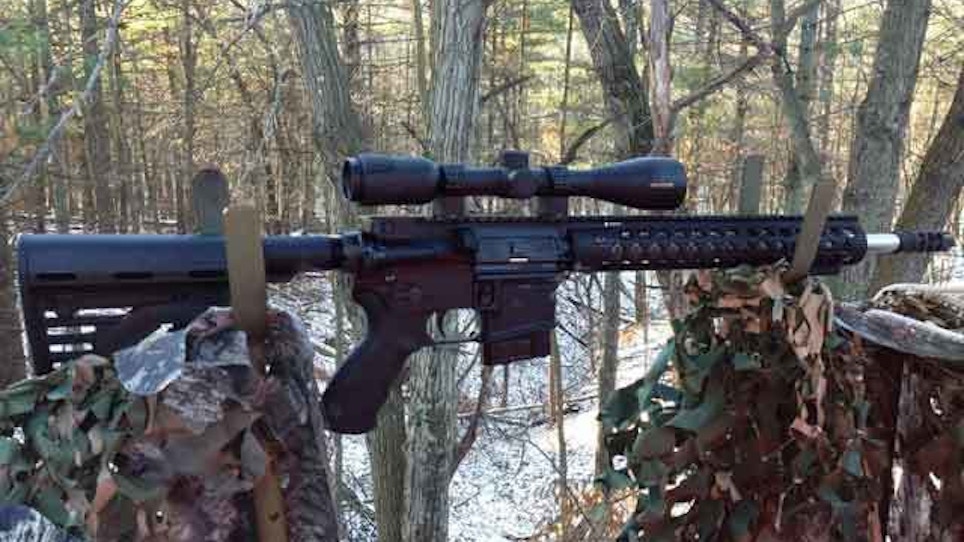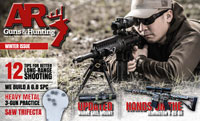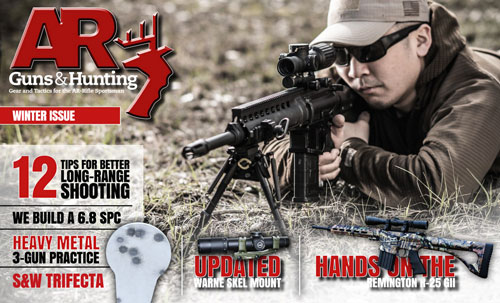Featured in AR Guns & Hunting, a FREE Digital Magazine
Modern sporting rifles (MSRs) are available in a range of configurations. But at their core, there are two main platforms to choose from. First is the popular AR-15 platform, which supports smaller-cartridge calibers such as .204 Ruger, .300 AAC Blackout, .223 Rem. and more. Second is the bigger, older brother, the AR-10 platform, which supports larger rounds such as .260 Rem., .308 Win., .338 Federal and more.
Most big-game hunters choose to hunt with calibers within the AR-10 platform, which provides more knockdown power with larger bullets. These AR-10 rifles are typically larger, longer and heavier than AR-15s. However, I really wanted to hunt deer with my smaller AR-15 rifle due to its light weight and easy maneuverability.
Although deer hunting with a .223 Rem. round is legal in most states (be sure to check your state’s hunting regulations), I personally believe it’s too small for where I hunt. In the Midwest, where thick brush is common, large-body bucks require more powerful ammunition. Through online research and conversations with friends, I discovered the 6.8 SPC option.
The 6.8 SPC round is based upon the .30 Remington cartridge. Typically, it provides more than 40 percent additional downrange energy than .223 Rem. In fact, it is midway between the .223 Rem and .308 Win. in bore diameter and muzzle energy. This means the 6.8 SPC is one of the largest rounds for the AR-15 platform. Ammunition manufacturers such as Federal Premium offer heavy bullets specifically tailored to hunting big game, such as the new 115-grain FUSION MSR.
The overall performance and bullet weight of the 6.8 SPC would be suitable for my deer hunt. However, I could not find a complete upper that I liked, so my friend Brent Cook and I set out to build an upper to install on my AR-15 MSR lower.
Parts And Assembly
In general, building a complete upper receiver assembly for an MSR requires a small number of parts to purchase. Although the task is not overly difficult, a modest level of experience and a few special tools are recommended. Cook has past experience assembling upper receivers and was a huge help. However, without a local expert or friend to help, other instructional sources are available. Websites, DVDs and books are all available to teach you how to build upper receivers.
Below are the general basics that you need to know and a complete list of all the parts. I found all the ingredients I needed for this project on Brownells.com.
There is a large variety of the same parts to choose from when building a MSR upper. The selection is up to you. Brownells has a great website geared toward shooters and hunters who want to build their own MSR upper. Simply click on “Rifle Parts” and start searching for the list below. Purchase the ones that appeal to you most or that fit your budget.
Parts List:
6.8 SPC barrel
AR-15 barrel nut
AR-15 free-float handguard
AR-15 stripped upper receiver
6.8 SPC bolt carrier group
AR-15 upper parts kit — this bag of springs and pins contains the forward assist assembly, gas tube and other small necessities
AR-15 gas block assembly — low-profile for use with free-float handguard
AR-15 charging handle assembly
AR-15 muzzle brake-sized appropriately for barrel diameter
6.8 SPC magazine
General Assembly Instruction:
Install the forward assist assembly and ejection port cover onto the stripped upper receiver. Use a roll pin punch for installing the forward assist assembly. A second person to hold the upper while tapping pins and aligning parts is handy. Otherwise, an AR-15 upper receiver vise block also works.
Clean the threads on the upper receiver, threads on the barrel nut and barrel extension with a dry-spray degreaser/cleaner. Secure the upper receiver in a large shop vice in preparation to install the barrel. You’ll need an AR-15 upper receiver action block for this step.
Apply grease to the threads on the upper receiver, threads on the barrel nut and barrel extension. My friend, Cook, uses Aeroshell 33MS, which is very close to what is recommended on military specifications.
Slide the barrel into the upper receiver. Ensure that the alignment pin in the barrel extension fully engages into the notch on the upper receiver and the shoulder on the barrel extension fully seats against the front of the receiver.
Hand-tighten the barrel nut onto the upper receiver. Cook usually does this a couple of times to ensure that the grease is evenly distributed.
Using an armorer’s wrench and a torque wrench, install the barrel nut to 35 ft./lbs. of torque and then back it off. Repeat the process one more time and then do a final torque to 35 ft./lbs. This procedure is intended for the installation of a stock barrel nut. Proprietary barrel nuts for other rail systems may have a different procedure. Read your instructions.
If the gas tube hole in the upper receiver does not align with one of the notches in the barrel nut, tighten the barrel nut until the next available notch is aligned. The gas tube or a drill bit approximately the size of the gas tub can be used to confirm alignment.
Install the gas block onto the barrel, ensuring that the gas port is properly aligned. Most barrels have a dimple that is on the bottom of the barrel directly under the gas port. Use this to assist with alignment as the rear screw on the gas block will mate into the dimple. For extra insurance, Cook typically adds a second dimple on the barrel for the front screw of the gas block. For this, he uses an AR-15 gas block dimpling jig. Use a thread locking compound that is not temperature sensitive, such as Rocksett, on the gas block set screws.
Test fit the bolt carrier group and charge handle into the upper receiver to confirm that the gas tube is aligned properly. If there is friction, the bolt carrier will not fully seat. This means the barrel nut is probably not fully aligned with the gas port hole.
Install the muzzle brake per the instructions supplied by the manufacturer. The gas tube can be used for alignment with devices that are required to be cocked in a certain orientation.
Install the handguard onto the barrel nut per directions supplied by the manufacturer. For designs like the Troy Alpha Rail, a detachable carry handle or scope mount can be used to maintain upper rail alignment while tightening the mounting screws. Install the alignment device so that it bridges the gap between the rail and receiver.
Crack a beer and marvel at your manliness as you have just assembled a major part of a firearm: A MSR upper!
Built For A Lifetime
For accessories, I choose the new Weaver Grand Slam 3-12x42mm riflescope with Weaver Tactical-Style 4-hole Rings, a Magpul Quick-Detach Sling Adaptor and a BLACKHAWK! Stretch Sling. I sighted in with Federal Premium FUSION MSR ammunition, which shot excellent groups at 100 yards.
Unfortunately, due to a busy work schedule, I only had two days to hunt with my new rifle, and I was unable to fill a tag. But buying and building the upper was fun enough. Also, my new MSR deer gun is built for a lifetime of hunts. You can bet it will be with me in the deer stand next year, and many more years to come.
For more AR-15 gear, tactics, tips, and hunting stories check out AR Guns & Hunting.
Never miss an issue!








